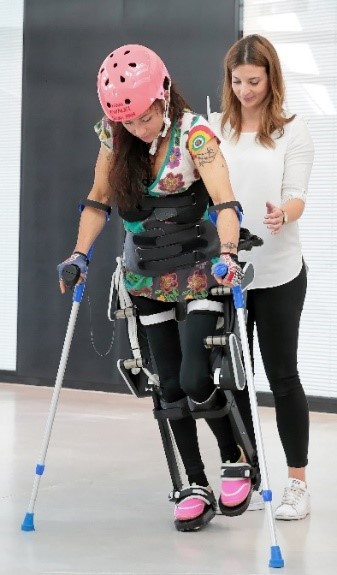A lower limb exoskeleton helps its wearer to walk again.
Exoskeletons are wearable orthotic devices, almost always instrumented and rigidly interfaced with the wearer. Powered exoskeletons are motorized with the objective to assist in walking or mobilize the legs to walk. No treadmill and no body weight support are required. A closed-loop-controlled movement or torques are transmitted to the limbs. Several developments and devices arising from academia and proposed as commercial products exist. They mainly differ in their actuated and non-actuated degrees of freedom, the types of materials used in their construction, and the implemented control strategies.
Exoskeletons are worn by users to enable them to walk again either for rehabilitation purposes or for activities of daily living. The device continuously interacts with the user by transmitting torques or movements to the limbs.

These interactions consist of the main topic of innovation both on the hardware side concerning the design of the device and placement of the sensors and on the control side with motion-induced strategies. Distinctions are made between mobilization and walking assistance. In the case of mobilization, precomputed gait trajectories are used to impose a desired gait when walking, while in walk assistance the locomotion controller must adapt the joint actuation to the intent and the capabilities of the user.
In our group, we believe that a universal exoskeleton cannot be efficient for everyone and every need. The modularity of the design is one of our targeted challenges. How to address the different specifications, while being as efficient in the process of customization and time of manufacturing (ToM) for the different handicaps and users?
The solutions developed by REHAssist are separated into two categories: 1) full mobilization exoskeletons (TWIICE) and 2) partial assistance exoskeletons (HiBSO, Autonomyo).
We developed a common control platform which is used by all our exoskeletons. This platform includes an embedded computer, power electronics and sensor modules. This makes the mechatronic design and the software programming consistent between devices, and faster.
These exoskeletons are actually autonomous, thanks to their built-in battery and wireless communication. They are then able to operate outdoor without the need of any external equipment.